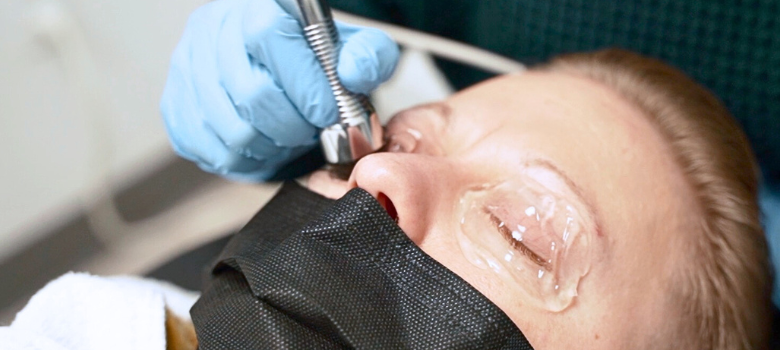Introduction to Ocular Surface Disease

Ocular Surface Disease (OSD) is a complex condition that encompasses a range of disorders affecting the surface of the eye. These disorders can significantly impact a person’s vision and overall quality of life. Commonly, OSD includes conditions such as Dry Eye Syndrome, blepharitis, Meibomian Gland Dysfunction, ocular rosacea and various forms of conjunctivitis. Each of these conditions, though distinct, shares a common theme: they disturb the delicate balance of the tear film and ocular surface, leading to discomfort, visual disturbance, and, in severe cases, vision impairment.
At Island Eyecare, we understand the intricacies of Ocular Surface Disease and its profound impact on daily activities. Whether it’s difficulty in reading, discomfort while using digital devices, or challenges in environmental conditions, OSD can be a debilitating companion. Our commitment is to provide not only relief but also a path to long-term ocular health. We are dedicated to exploring the characteristics of Ocular Surface Disease (OSD), treating its symptoms, and understanding how it intertwines with your lifestyle and overall well-being.
Patient Challenges and Symptoms of Ocular Surface Disease
Ocular Surface Disease presents a spectrum of symptoms, each uniquely impacting the lives of those affected. Patients commonly report a range of discomforts, which can significantly hinder their daily activities and overall quality of life. Here are some of the typical challenges and symptoms associated with OSD:
Each patient’s experience with Ocular Surface Disease is unique, with symptoms ranging from mildly annoying to severely debilitating. At Island Eyecare, we take these challenges seriously, understanding that they are not just symptoms, but barriers to a comfortable, productive life. Our approach to treatment starts with listening to your experiences and tailoring our care to address your specific needs.
Leading The Way in Ocular Disease Detection with Cutting-Edge Technology
Precision Diagnostics for Ocular Surface Disease
At Island Eyecare, our diagnostic approach to Ocular Surface Disease (OSD) is grounded within a precise and comprehensive system. We utilize advanced techniques that include AI-assisted Meibomian Gland analysis for accurate diagnosis of Meibomian Gland Dysfunction, enhanced imaging for early detection of corneal epithelial staining, and full cornea dry eye analysis with a Placido ring projection system. Our fully automatic digital module streamlines anterior segment examinations, ensuring efficient and detailed assessments.
Additionally, we employ specialized questionnaires for preliminary dry eye assessment, automated non-invasive breakup time, and tear meniscus height measurements. We also conduct thorough analyses of the eyelid margin, conjunctival hyperemia, and corneal staining. These state-of-the-art diagnostic tools enable us to accurately evaluate the extent and nature of OSD, providing a solid foundation for our personalized treatment strategies.
At Island Eyecare, we take a holistic approach to Dry Eye Syndrome, focusing not only on advanced treatments but also on lifestyle advice like screen management and dietary changes. Understanding the chronic nature of the condition, we are committed to providing ongoing support and adapting our methods to ensure your long-term eye health and overall well-being.
Comprehensive and Personalized Diagnosis

Starting with a thorough evaluation of your eye health, our advanced diagnostic tests assess tear film and Meibomian Gland functionality. This detailed approach ensures we identify the specific causes of Dry Eye Syndrome, including Meibomian Gland Dysfunction (MGD).
Customized Medical Treatments

Our treatment plans are designed to meet each patient’s unique needs. This may include:
- Prescription Eye Drops: Targeting inflammation and stimulating tear production.
- Artificial Tears: Providing immediate relief for dryness.
- Advanced Procedures: Incorporating IPL (Intense Pulsed Light) therapy and RF (Radio Frequency) treatment with manual gland expressions, especially beneficial for MGD.
Focused Lid Hygiene

A critical component for managing MGD, we emphasize the importance of regular lid cleaning and warm compresses, guiding patients on effective techniques to maintain healthy gland function.
High-Quality Nutritional Supplements

We recommend premium supplements that are specifically formulated to support eye health, ensuring they are sourced from reputable suppliers.
Skin Care Products

We understand the importance of skin health in relation to eye comfort. Our recommendations include gentle, eye-friendly skin care products that complement your dry eye treatment.
“Going to Island Eyecare and meeting Dr. Narang was the best decision for my vision health. She has given me a regimen of lifestyle tips, supplements, and some high-tech care that is really working.”
“Dr. Narang at Island Eyecare really knows her stuff. She explained how she could help my dry eye problem by using an expression technique. Combined with their Inmode treatments, my eyes feel relief like never before.”
“Struggling with dry eyes everyday was tough, but Dr. Narang had the solution. She put together a personalized plan for me, and I can’t tell you how much better my eyes feel. It’s like I’ve finally found the relief I needed.”
“Dr. Narang’s approach to eye care is something else! She combined high-tech Forma-i treatments with gland expression, and my eyes feel the best they have in years. It’s amazing how much better my quality of life is now.”
“I used to have this constant eye irritation, but Dr. Narang at Island Eyecare recommended a combo of natural supplements and the latest treatments. I was skeptical at first, but the relief I’ve experienced speaks for itself.”
“I had this annoying eye issue called Demodex and Dr. Narang knew exactly what to do. She used advanced treatments, and I can finally say my eyes are feeling so much better.”
“I was struggling with dry eyes for years, but Dr. Narang at Island Eyecare changed that. She introduced me to some new treatments called Form-i and Lumecca-i. I finally have relief.”
“Before I met Dr. Narang, I had no idea what Meibomian Gland Dysfunction was. She explained everything and set me up with a comprehensive treatment plan. The relief I feel is night and day.”
“I have Rosacea, and it was affecting my eyes quite badly. Dr. Narang used a treatment called Lumecca-i, and wow, what a difference! My eyes don’t feel irritated all the time anymore.”
Articles from Island Eyecare

